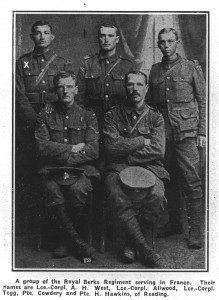Frederick Edward Wilcox
Sapper 96365
204th Field Company Royal Engineers
Division 63
 |
Frederick Edward Wilcox was the youngest son of George and Elizabeth Wilcox.
He had two older brothers and one older sister. Frederick was born in Slough although his parents were from Reading and the family had resettled in Reading at the time of the 1911 census. George Wilcox was then a widower aged 65 years. The family home was run by daughter Louisa May, aged 30, who also worked at home as a dressmaker. Albert, who was 5 years older than Frederick was also living at home and was the manager of a grocers shop. In 1911, George’s second son, Henry Charles was working as a Coppersmith and boarding in Northamptonshire. He worked for a firm of motor body builders. The Green family with whom he boarded worked in the shoe trade. Like his father Frederick worked for the Great Western Railway.
Frederick Wilcox married Florence Chamberlin in the first quarter of 1915 and enlisted in May the same year. The couple had made their home at 133, Cumberland Road, Reading.
Frederick was killed in action on the 31 May 1916, aged 28. By this time he had been married sixteen months and the couple had a child.
The circumstances under which Frederick met his death are unknown. There are no service records pertaining to Frederick Wilcox other than his name on the Medal Role. However, an extract of a letter to Florence from Frederick’s Commanding Officer was published in the Standard 17th June 1916.
“All the men and myself miss him very much. He was so willing, so cheerful and so brave, for he set us all a splendid example and we are proud to have had such a man in our company. He was buried, not where he fell, but in a beautiful English cemetery near other of his comrades”.
The English cemetery is St. Vaast Post Military Cemetery, Richebourg-L’Avoue. Location III. K.4. The cemetery stands in an old orchard between two farm buildings, where a tramway had its terminus and a dressing station was established. The cemetery was begun in May, 1915, at the time of the Battle of Festubert, and was used by fighting units and Field Ambulances until July, 1917.



